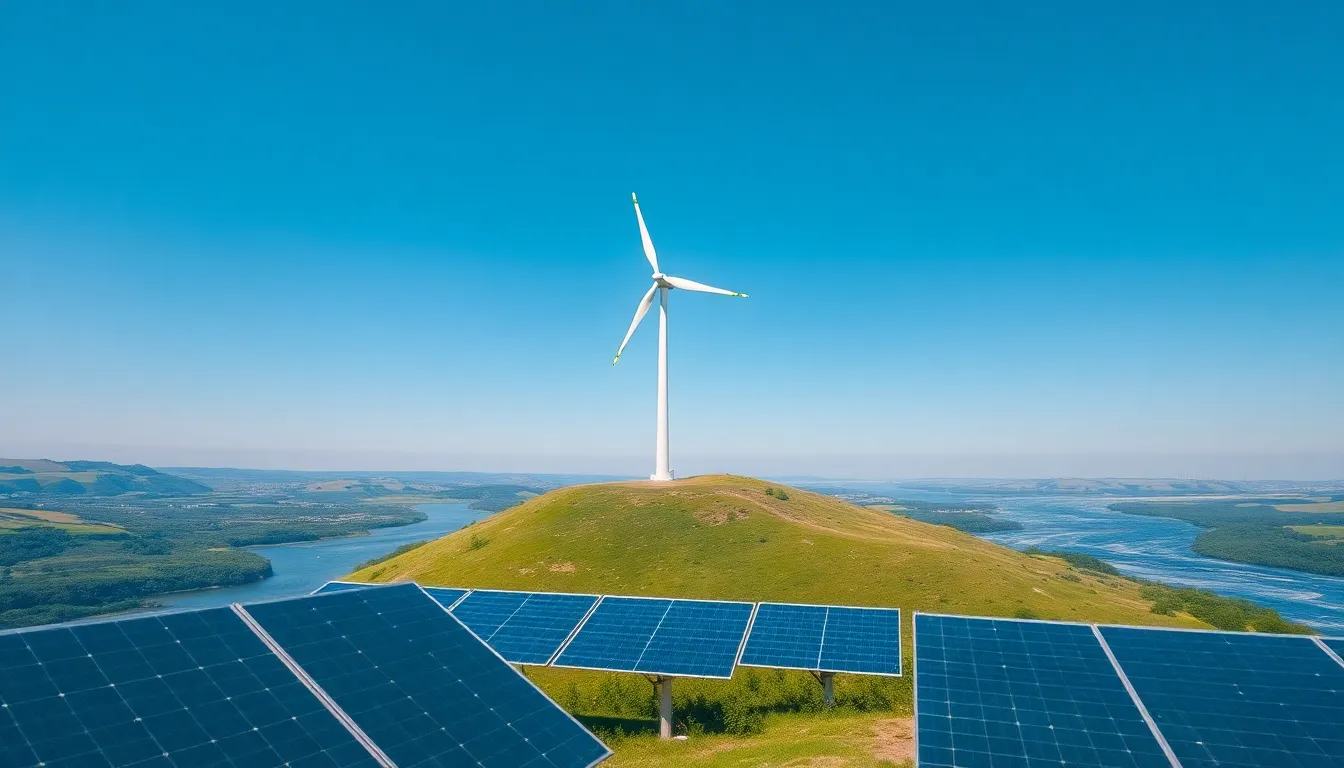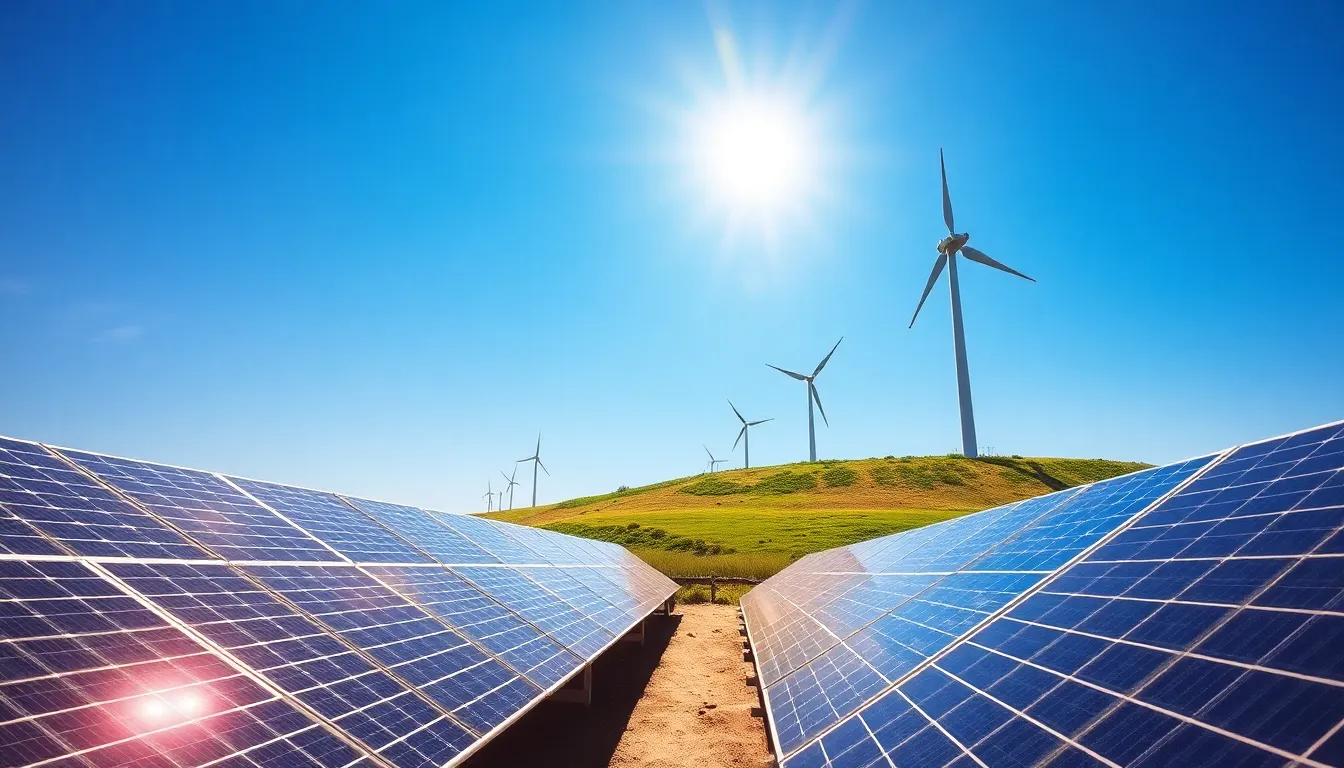In a world where climate change feels like that one annoying relative who just won’t leave the party, zero emissions tech is the life-saving bouncer everyone’s been waiting for. Imagine a future where clean air is the norm and our planet isn’t gasping for breath. Sounds dreamy, right? Well, it’s not just a fantasy; it’s happening now, and it’s about time we pay attention.
Table of Contents
ToggleOverview of Zero Emissions Tech
Zero emissions technology encompasses various innovations aimed at eliminating greenhouse gas emissions across multiple sectors. These technologies include renewable energy sources like solar, wind, and hydroelectric power. Renewable sources generated 29% of the global electricity in 2020, showcasing their potential impact.
Electric vehicles represent another critical component of zero emissions tech. The global electric vehicle market is projected to reach 26.4 million units by 2030, significantly reducing emissions from transportation. Additionally, advancements in battery technology enhance the efficiency and range of electric vehicles.
Carbon capture and storage (CCS) plays a vital role too. This technology captures carbon dioxide emissions from industrial sources, preventing them from entering the atmosphere. It is estimated that CCS could contribute to a 14% reduction in global emissions by 2050, indicating its importance in achieving climate goals.
Energy efficiency improvements also fall under the zero emissions umbrella. Upgrading buildings with high-efficiency insulation and smart technologies can lead to substantial energy savings. Studies show that improved energy efficiency measures in buildings could reduce global energy demand by 30% by 2050.
Innovative agricultural practices are critical for creating a sustainable future. Techniques such as regenerative farming and precision agriculture enhance soil health and reduce emissions from traditional farming methods. A shift toward these practices could lower agricultural emissions by 30% by 2030.
Collectively, these zero emissions technologies present a comprehensive approach to combating climate change. Each initiative contributes to a cleaner, healthier planet, making it essential to prioritize their development and implementation.
Key Technologies Driving Zero Emissions


Zero emissions technology includes a range of innovations designed to eradicate greenhouse gas emissions across various sectors. They hold significance in creating a sustainable future.
Renewable Energy Sources
Renewable energy sources such as solar, wind, and hydroelectric power serve as foundational elements in achieving zero emissions. In 2020, these sources generated 29% of global electricity. Solar energy harnesses sunlight to produce electricity, while wind energy captures airflow through wind turbines. Hydroelectric power utilizes flowing water to generate energy, providing reliable and sustainable electricity. Transitioning to renewables can significantly decrease reliance on fossil fuels, facilitating an essential shift towards a cleaner energy landscape.
Energy Storage Solutions
Energy storage solutions play a pivotal role in stabilizing renewable energy use. Battery storage technologies, such as lithium-ion batteries, enable the storage of surplus energy generated during peak production times. This stored energy becomes critical for balancing supply and demand, particularly when renewable generation fluctuates. By storing energy for later use, these systems support grid stability and enhance the efficiency of renewable resources, allowing for a smoother transition to a zero emissions future.
Carbon Capture and Storage
Carbon capture and storage (CCS) technology is vital in mitigating climate change impacts. CCS captures up to 90% of carbon dioxide emissions produced from fossil fuel use in electricity generation and industrial processes. The captured carbon dioxide is then transported and stored underground in geological formations. This technology could contribute to a 14% reduction in global emissions by 2050, complementing efforts made by renewable energy adoption. Effective implementation of CCS enhances industrial sustainability while making substantial strides towards zero emissions.
Applications of Zero Emissions Tech
Zero emissions technology finds diverse applications across multiple sectors, effectively contributing to climate change mitigation and enhancing sustainability.
Transportation Sector
Electric vehicles lead the charge in transportation advancements. The market is set to reach 26.4 million units by 2030, enabling significant reductions in transportation emissions. Charging infrastructure improvements complement vehicle growth. Furthermore, hydrogen-powered vehicles also emerge as viable alternatives, especially for long-haul transportation. Sustainable public transportation options, including electric buses and trams, help decrease overall emissions in urban areas. Together, these innovations support a cleaner mobility future.
Industrial Processes
Industries increasingly adopt zero emissions technology to minimize their ecological footprint. Solutions like carbon capture and storage (CCS) capture up to 90% of carbon dioxide emissions from fossil fuel use. Additionally, many companies utilize renewable energy sources to power production lines, drastically cutting greenhouse gas emissions. Moreover, energy efficiency measures, such as optimizing equipment and processes, lead to substantial energy savings. Regenerative manufacturing processes focus on using resources sustainably, ensuring that industrial practices contribute positively to the environment.
Residential Buildings
Residential buildings leverage zero emissions technology to enhance energy efficiency and reduce carbon footprints. High-efficiency insulation drastically cuts heating and cooling demands. Smart technologies, such as programmable thermostats and energy management systems, optimize energy use in homes. Solar panels allow residents to harness renewable energy directly from sunlight, further facilitating emission reductions. Additionally, electric heating systems replace traditional gas systems, offering cleaner alternatives for indoor climates. Collectively, these strategies create sustainable living environments.
Benefits of Implementing Zero Emissions Tech
Implementing zero emissions technology brings numerous advantages across various sectors. First, cleaner air improves public health, leading to reduced respiratory illnesses linked to pollution. Enhanced energy efficiency saves costs; for example, high-efficiency insulation can lower heating bills significantly.
Greenhouse gas reductions are notable, with carbon capture and storage technology having the potential to capture up to 90% of emissions. In various aspects of agriculture, innovative practices could minimize emissions by 30% by 2030. These strategies help secure food sources while lowering environmental impacts.
Economic benefits also arise from transitioning to electric vehicles, which are projected to create a booming market of 26.4 million units by 2030. This switch supports job creation in manufacturing, infrastructure development, and maintenance sectors. Furthermore, renewable energy sources like solar, wind, and hydroelectric power account for 29% of global electricity generation, enhancing energy independence for many nations.
Investments in zero emissions technology stimulate innovation. Companies embracing these technologies often enhance their reputation and attract environmentally conscious consumers. Improved public transport options, underpinned by zero emissions strategies, reduce traffic congestion and promote sustainable urban development.
Flexible energy storage solutions, particularly lithium-ion batteries, contribute to grid reliability by enabling surplus energy storage. These capabilities ensure that renewable resources maintain a stable supply, addressing energy demand fluctuations. From residential to industrial applications, zero emissions technology paves the way for a cleaner, more sustainable future.
Advantages linked to zero emissions technology extend beyond environmental benefits. Enhanced health outcomes, cost savings, economic growth, and energy independence reflect the broad impact of these innovations across society.
Challenges and Limitations
Adopting zero emissions technology faces several challenges. High upfront costs present a significant barrier for many businesses seeking to invest in renewable energy solutions. Transitioning existing infrastructure to zero emissions systems requires substantial financial commitment and time.
Technological limitations also impede progress. Current battery storage solutions are limited in capacity, affecting the reliability of renewable energy sources. Research continues to advance, but achieving breakthroughs that enhance efficiency remains necessary.
Regulatory hurdles create additional obstacles. Policies and regulations vary widely across regions, complicating the implementation of consistent zero emissions initiatives. Navigating these diverse frameworks often requires substantial resources and expertise.
Public acceptance poses another challenge. Although awareness of climate issues grows, resistance to change remains prevalent in some communities. Educating the public on the advantages of zero emissions technology can help to drive acceptance and support.
Supply chain issues complicate sourcing materials needed for zero emissions technologies. Critical components like lithium for batteries and rare earth metals face fluctuating availability and high demand. This reliance on specific materials can lead to bottlenecks that delay widespread adoption.
Job displacement in traditional energy sectors raises concerns about the socioeconomic impact of this transition. Reskilling and job training programs for displaced workers are essential to support a smooth transition into green jobs. Addressing these labor market shifts is crucial for maintaining public support.
Overall, overcoming these challenges requires collaboration among governments, businesses, and communities. By prioritizing solutions, stakeholders can pave the way for a more sustainable future built on zero emissions technology.



